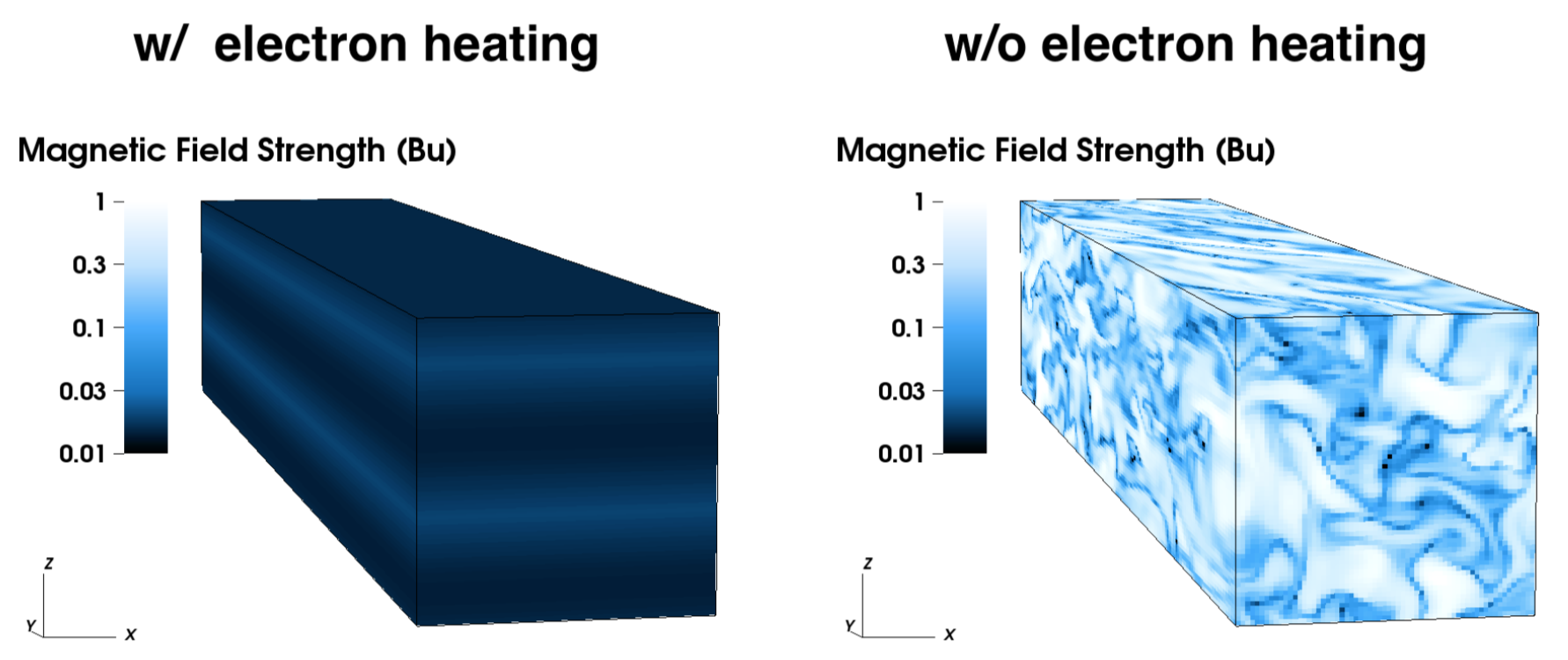Reserch Interests
我々が住む地球にはなぜ生命が存在するのか?地球はどのような歴史を辿ったのか?地球と他の惑星との違いはどこから生まれたのか?他の惑星にも生命は存在しうるのか?そういった疑問に答えるのが惑星科学です。 私は惑星の形成過程を明らかにすることで、これらの問いに答えることを目標としています。 惑星の形成過程を解明する上で、その形成環境である原始惑星系円盤(星形成時に存在する星周囲の円盤状のガス)における力学構造を解明することが重要です。 原始惑星系円盤はわずかに電離しており、磁場と相互作用することが知られています。 私は、ガスと磁場との相互作用を数値計算を用いて解くことで、原始惑星系円盤の描像を理論的に解明することを目指しています。
I am broadly interested in theoritical and observational topics on the planet formation. In relation to the planet formation, I am also interested in the physical properties of protoplanetary disks. My scientific goals is to reveal the planet formation based on picture of protoplanetary disks consistent with both theory and obsetvations. My main expertise lies in magnetohydrodynamics, microphysics of ionization reaction, and energy transport in protoplanetary disks. My research is performed by analytical calculation and magnetohydrodynamical simulation.
Reserch Overview
原始惑星系円盤の乱流
Turbulence in Protoplanetary Disks
電子加熱が原始惑星系円盤の乱流に与える影響
Influence of electron heating on turbulence in protoplanetary disks
原始惑星系円盤の乱流は、原始惑星系円盤の進化と構造、および惑星形成過程に大きく影響します。 原始惑星系円盤の乱流は、磁気回転不安定性(MRI)と呼ばれる磁場の不安定性によって生じると考えられています。 MRIが成長するかどうかは電離率に強く依存します。
私はこれまで原始惑星系円盤のMRIと電離状態化率に注目してきました。 特に、MRI由来の電場が電離率とMRIに与える影響を調べました。 強い電場は電子を加熱し、電子温度を上昇させます。 (私たちはこれを強電場による電子加熱と呼んでいます。) 加熱された電子は円盤中の塵に吸収され、最終的に電離度が低下します。 このメカニズムは、MRIを抑制することができると期待できます。 我々はこの機構に関して2つの論文を書きました[1,2]。 最初の論文は、どこで電子加熱がMRI乱流に影響を与えうるか調べました。 2番目の論文では、電子加熱の効果を考慮した磁気流体力学シミュレーションを行い、 電子加熱によってMRI乱流が抑制されうることを確認しました。
Turbulence in protoplanetary disks (PPDs) largely affects the evolution and structure of plotoplanetary disks and the planet formation process. The turbulence in PPDs is thought to be generated by an instability of magnetic fields in Kepler rotating disks, which is known as a magnetorotational instability. Whether or not MRI grows depends on the ionization fraction because the magnetic fields are decoupled from neutral gas in the weakly ionized state.
I have focused on the MRI and ionization state in PPDs. Especially, I have investigated the effect of the MRI-induced electric fields on the ionization fraction and MRI activity. Strong electric field heats electrons and increases the electron temperature. (We call this mechanism as electron heating by electric fields.) In turn, the heated electrons absorbs onto dust grains, and eventually the ionization fraction decreases. This mechanism can suppress the MRI. We have written two paper on this mechanism [1,2]. The first paper is on the location where the electron heating can affects on the MRI turbulence. In the second paper, we did MHD simulation including the electron heating, and confirmed that the MRI turbulence can be suppressed by the electron heating.

Rocky Planet Formation in Protoplanetary Disks
Temperature Structure in Protoplanetary Disks
The temperature profile of PPDs is a key parameter to understand the planet formation. Especially, accretion heating determines the temperature of disk's inner regions in the early phase of disk evolution. The conventional accretion heating model is based on the energy dissipation by viscosity of turbulence. However, previous magnetohydrodynamic (MHD) simulations showed that the flow in the disk can be laminar because of the effect of partial ionization. In this case, the energy dissipation occurs by Joule heating. Therefore, the temperature determined by the accretion heating can largely controlled by the Joule heating profile.
We perform local stratified MHD simulations including three nonideal MHD effects, and investigate the vertical temperature profile. We find that Joule heating occurs at high altitude due to the large ambipolar diffusion around the midplane. The absence of Joule heating near the midplane leads to the temperature at the midplane significantly lower than that with the conventional model. Our results suggest that the midplane temperature in disks’ inner region can be determined by irradiation heating rather than accretion heating even in the early stage of disk evolution.